When building a truck for rock crawling, low gears are probably the second most important item, right behind a good set of lockers. After I put a set of lockers into project Rock Runner I ran it through the Rubicon a couple of times. I made it through the trail with out any failures but did have a number of dents in the skid plates (and body). It was hard to control forward speed with the stock gearing. I found it took a lot of clutch work to keep moving forward while limiting speed. It was anything but graceful driving.
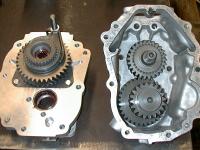 The key to driving slower is a truck's crawl ratio. Crawl ratio is the over all gear reduction provided by the drive train. To determine the crawl ratio of a truck, multiply the transmission first gear, low range transfer case gear and ring & pinion ratio. Before getting lower transfer case gears I had a set of 4.88 differential gears, 2.57 stock transfer case gears and 3.83 first gear in my transmission. This yields a crawl ratio of 48:1 ( 4.88 X 2.57 X 3.83 = 48 ). This is a great ratio for driving over sand dunes, dirt roads and such but does not work well at all on rock type trails.
The key to driving slower is a truck's crawl ratio. Crawl ratio is the over all gear reduction provided by the drive train. To determine the crawl ratio of a truck, multiply the transmission first gear, low range transfer case gear and ring & pinion ratio. Before getting lower transfer case gears I had a set of 4.88 differential gears, 2.57 stock transfer case gears and 3.83 first gear in my transmission. This yields a crawl ratio of 48:1 ( 4.88 X 2.57 X 3.83 = 48 ). This is a great ratio for driving over sand dunes, dirt roads and such but does not work well at all on rock type trails. 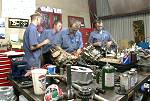
About a year ago I purchased a used, single Marlin 4.70 case from Jack Alford. This case retains the stock 1:1 high range ratio but reduces the low range to 4.7 to 1. This brought my overall crawl ratio down to 88:1, almost twice as low. The single 4.70:1 case is a bolt-in item and requires only minor modifications to the rear drive shaft. Most backyard mechanics should have little trouble installing one of these. Click here to see info about installing a single Marlin case. I found the lower gears made a huge difference on the trail when I went back earlier this year. The new gears were fantastic but as I used them I began to see the benefit of even lower reduction. I liked the lower gears and wanted even more! It was time to add a second reduction unit.
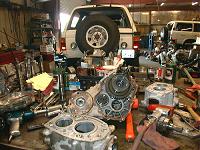 Single and dual case systems for Toyota's
Single and dual case systems for Toyota's
There are several different options for lower gears in Toyota trucks with manual transmissions. Advanced Adapters makes a 4:1 low range gear set for most 4cyl trucks. JP Eater and others make dual case systems for pickup's and 4Runners that could run two sets of stock gears or 4:1 gears. Marlin Crawler can build crawlers using 2.28, 4.00 or 4.70 gears in either single or dual configurations. Marlin can build with 21 spline 4cyl gears or the stronger 23 spline gears for turbo 4cyl applications, V6 and V8.
 The following is a chart showing the more common gear combinations available for building crawler cases. 2.28 (gear driven) and 2.57 (planetary) gears are stock, the 4.00 are Trail Tamer gears from Advanced Adapters. The 4.70 gears are from Marlin Crawler. To use the chart, start at the top and find your rear ring and pinion ratio, then move down the chart to see the effect of different transfer case gears on the crawl ratio. Single numbers in the left column are for single transfer case systems. When there are two numbers such as 2.28 X 2.28 this refers to a dual case systems. This chart is based on 3.93 first gear used in most Toyota's (Other common Toyota first gears are 3.83, 3.95 and 4.31)
The following is a chart showing the more common gear combinations available for building crawler cases. 2.28 (gear driven) and 2.57 (planetary) gears are stock, the 4.00 are Trail Tamer gears from Advanced Adapters. The 4.70 gears are from Marlin Crawler. To use the chart, start at the top and find your rear ring and pinion ratio, then move down the chart to see the effect of different transfer case gears on the crawl ratio. Single numbers in the left column are for single transfer case systems. When there are two numbers such as 2.28 X 2.28 this refers to a dual case systems. This chart is based on 3.93 first gear used in most Toyota's (Other common Toyota first gears are 3.83, 3.95 and 4.31)
Crawl Ratio Table
|
3:90 |
4:10 |
4:37 |
4:56 |
4:88 |
5:29 |
5:71 |
2.28 Stock 4cyl |
35:1 |
37:1 |
39:1 |
41:1 |
44:1 |
47:1 |
51:1 |
2.57 Stock 6 cyl |
39:1 |
41:1 |
44:1 |
46:1 |
49:1 |
53:1 |
58:1 |
Single 4.00 |
61:1 |
64:1 |
69:1 |
72:1 |
77:1 |
83:1 |
90:1 |
Single 4.70 |
72:1 |
76:1 |
81:1 |
84:1 |
90:1 |
98:1 |
105:1 |
Dual 2.28 X 2.28 |
80:1 |
84:1 |
89:1 |
93:1 |
100:1 |
108:1 |
117:1 |
Dual 2.28 X 4.00 |
140:1 |
147:1 |
157:1 |
163:1 |
175:1 |
190:1 |
205:1 |
Dual 2.28 X 4.70 |
164:1 |
173:1 |
184:1 |
192:1 |
206:1 |
223:1 |
240:1 |
Dual 4.00 X 4.00 |
245:1 |
258:1 |
275:1 |
287:1 |
307:1 |
333:1 |
359:1 |
Dual 4.00 X 4.70 |
288:1 |
303:1 |
323:1 |
337:1 |
361:1 |
391:1 |
422:1 |
Dual 4.70 X 4.70 |
338:1 |
356:1 |
379:1 |
396:1 |
424:1 |
459:1 |
495:1 |
You can see from the chart that changing the ring and pinion does make a difference. Transfer case gear changes make a larger difference and do so without changing highway RPM's because tcase changes only effect the low range part of the drive line.
It is best to choose ring and pinion gears that give the desired highway engine RPM. See the Toyota gear guide for help in choosing gears. Then low range crawling can be enhanced with transfer case gears.
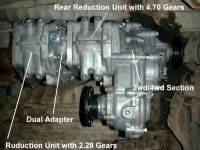
How does a dual case work?
A stock, gear driven Toyota transfer case is made up of two parts: the reduction half that provides the low range and the 4wd section that provides power to drive the front wheels. Marlin builds a dual case by taking the reduction unit off of one case and bolting it in front of a second complete transfer case using a special adapter plate. This second reduction unit and adapter plate adds about 6.5" to the length of the case and 40 pounds to the weight of the truck. 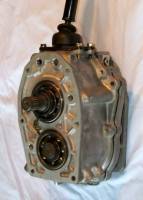 If your considering a dual case for your truck, you can purchase a good used core for around $125 with stock gears in it. Adding lower gears to a second case adds $700-$800 to the cost. Then, with Marlin's dual kit, you can attach the case to your stock transfer case.
With a dual case you can choose to use one or both reduction units. With the 2.28 / 4.70 combination of gears and stock 5 speed gives a total of 20 forward and 4 different reverse gear combinations. With both reductions units in operation the transfer case reduction is 10.7:1. The following table shows all of the different gear selections now available. This table is based on my 4:88 differential gears and R150F (V6) 5-Speed manual transmission.
If your considering a dual case for your truck, you can purchase a good used core for around $125 with stock gears in it. Adding lower gears to a second case adds $700-$800 to the cost. Then, with Marlin's dual kit, you can attach the case to your stock transfer case.
With a dual case you can choose to use one or both reduction units. With the 2.28 / 4.70 combination of gears and stock 5 speed gives a total of 20 forward and 4 different reverse gear combinations. With both reductions units in operation the transfer case reduction is 10.7:1. The following table shows all of the different gear selections now available. This table is based on my 4:88 differential gears and R150F (V6) 5-Speed manual transmission.
|
Reverse
(4.220) |
1st Gear
(3.830) |
2nd Gear
(2.062) |
3rd Gear
(1.436) |
4th Gear
(1.000) |
5th Gear
(0.838) |
Hi Range |
21:1 |
19:1 |
10:1 |
7:1 |
5:1 |
4:1 |
2.28 |
47:1 |
43:1 |
23:1 |
16:1 |
11:1 |
9:1 |
4.70 |
96:1 |
88:1 |
47:1 |
32:1 |
23:1 |
18:1 |
2.28 & 4.70 |
221:1 |
200:1 |
108:1 |
75:1 |
54:1 |
44:1 |
With my stock tcase gears my crawl ratio was about 48:1. When I installed the single case with marlin 4:70 gears it went down to 88:1.  Now with the second reduction unit my crawl ratio is now 200:1 with both cases in low range and the tranny in first gear. Now with the second reduction unit my crawl ratio is now 200:1 with both cases in low range and the tranny in first gear.
To install the dual Marlin case the first thing we did was to remove the crossmember and drive shafts. Then we unbolted and dropped my transfer case out. While we had the case out of the truck Marlin opened it up and inspected it. All the parts were in excellent condition and it was reassembled.
The second reduction core was completely disassembled and cleaned. Every bit of dirt and grease was removed. The case looked like factory new. The original gears and bearings were in good condition and were reinstalled with new seals. The factory 21 spline (4 cyl) input gear was replaced with a 23 (V6/Turbo) spline unit. 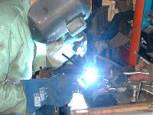 This matches the 23 spline shaft size and strength used in the transmission and rear transfer case. The rebuilt reduction unit was attached to my transfer case using a new double bearing adapter plate. This new design provides more strength and smoother operation than previous designs. New oil galleys direct more oil into the bearing for greater life. The process of building the Crawl Box requires a key-way to be welded on to a shift fork and main shaft to be pressed apart but is mostly a bolt together affair. If you are interested in learning more about this, see the page written by Jay Kopycinski on Marlin's web site. This matches the 23 spline shaft size and strength used in the transmission and rear transfer case. The rebuilt reduction unit was attached to my transfer case using a new double bearing adapter plate. This new design provides more strength and smoother operation than previous designs. New oil galleys direct more oil into the bearing for greater life. The process of building the Crawl Box requires a key-way to be welded on to a shift fork and main shaft to be pressed apart but is mostly a bolt together affair. If you are interested in learning more about this, see the page written by Jay Kopycinski on Marlin's web site. 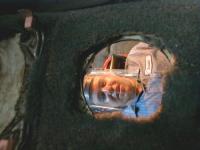
The dual case unit was test fitted into the truck. A mark was made on the drive shaft tunnel. The dual case was then removed. Then a 3.5" hole saw was used to drill through the floorboard to make room for the added shifter.
Marlin and his staff looked over the interior of the truck before starting and agreed the shifter could be brought up in a factory looking location in the center console.  Due to the limited space available for the added shifter a Marlin Crawler short throw adapter was used to reduce the movement of the rear shifter and minimize the need to trim more plastic. A hole was cut into the console and the shifter was cut and offset forward about 1/2" so that it would come up in just the right place. Marlin regularly spends a lot of time on this part of the installation. After seeing several dual case installations he has done in the past I can see why Marlin is famous for being able to bend and create all sorts of different shifter arrangements to fit most any truck's interior. A new factory shift boot was used to cover the hole in the floor and make a smooth transition up to the console. Due to the limited space available for the added shifter a Marlin Crawler short throw adapter was used to reduce the movement of the rear shifter and minimize the need to trim more plastic. A hole was cut into the console and the shifter was cut and offset forward about 1/2" so that it would come up in just the right place. Marlin regularly spends a lot of time on this part of the installation. After seeing several dual case installations he has done in the past I can see why Marlin is famous for being able to bend and create all sorts of different shifter arrangements to fit most any truck's interior. A new factory shift boot was used to cover the hole in the floor and make a smooth transition up to the console.
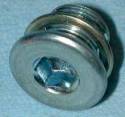 New low profile magnetic drain plugs were used to help prevent oil drainage on the trail. I have been running a set of these in my differentials for about a year now. Since changing over to them I have not had anymore problems with the drain plugs being knocked loose by rocks on the trail. When used on differentials a steel washer should be used. When used on aluminum transfer cases an aluminum washer should be used.
New low profile magnetic drain plugs were used to help prevent oil drainage on the trail. I have been running a set of these in my differentials for about a year now. Since changing over to them I have not had anymore problems with the drain plugs being knocked loose by rocks on the trail. When used on differentials a steel washer should be used. When used on aluminum transfer cases an aluminum washer should be used. 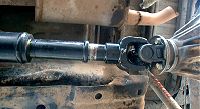
Due to the extra 6.5" length of the second reduction unit and adapter plate it was necessary to lengthen the front drive shaft and shorten the rear drive shaft. For best fit I would recommend taking measurements for the drive shafts after installing the dual case. For the front drive shaft I lengthened my Gloeco drive shaft.
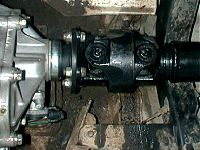 For the rear drive shaft I used a front 1985 drive shaft with factory CV joint. This drive shaft was lengthened to fit with heavy wall tubing for extra strength. In some applications shortening the rear drive shaft may cause vibrations. A CV joint can reduce vibration problems as long as the pinion angle is not too much. When my rear leaf spring mounts were welded on during my coil to leaf spring conversion I choose to point the pinion a few degrees below the transfer case output. This way when I later added the dual case and CV drive shaft the angles would be correct. Other ways to angle the pinion up a little include degree shims and longer shackles.
For the rear drive shaft I used a front 1985 drive shaft with factory CV joint. This drive shaft was lengthened to fit with heavy wall tubing for extra strength. In some applications shortening the rear drive shaft may cause vibrations. A CV joint can reduce vibration problems as long as the pinion angle is not too much. When my rear leaf spring mounts were welded on during my coil to leaf spring conversion I choose to point the pinion a few degrees below the transfer case output. This way when I later added the dual case and CV drive shaft the angles would be correct. Other ways to angle the pinion up a little include degree shims and longer shackles. 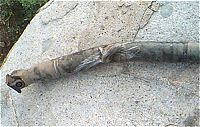
Another advantage to the CV drive shaft is that it places the large tubing of the drive shaft up and out of harms way. The tubing is the drive shafts weakest part and can be bent or dented when driving through rocks. By mounting the tubing side nearer the transfer case damage to this tubing can be limited somewhat. On some trucks it is possible to remove and reinstall the stock drive shaft backwards and thus moving the tubing up and out of the way.
On my truck the long front travel and tall lift combined with moving the transfer case rearward 6.5" causes the front drive shaft to hit the stock crossmember. To solve this problem normally the crossmember is normally clearance a little with a hammer. In my case it would be necessary to cut a notch and add some steel in order to keep the stock crossmember.
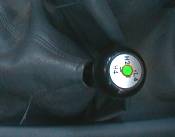 With a dual case setup you have two transfer case shifters. The forward shifter operates the "Crawl Box". This shifter only moves forward and backward and not in the normal J pattern like a stock transfer case. It has only 3 positions: Low range, neutral and high range. As an optional extra, Marlin offers a lighted shift lever for the Crawl Box. This light is separate from the 4wd light in the transfer case. This small green light comes on when the front Crawl Box is in low range. With all the gear combinations available it's handy to see at a glance if the Crawl Box is engaged. The shift light requires a custom modified shift fork inside the Crawl Box. The lighted shift lever must be ordered with the dual case. If ordered at a later time the crawler must be disassembled to modify the shift fork. The lighted shift lever uses a factory type switch for reliability.
With a dual case setup you have two transfer case shifters. The forward shifter operates the "Crawl Box". This shifter only moves forward and backward and not in the normal J pattern like a stock transfer case. It has only 3 positions: Low range, neutral and high range. As an optional extra, Marlin offers a lighted shift lever for the Crawl Box. This light is separate from the 4wd light in the transfer case. This small green light comes on when the front Crawl Box is in low range. With all the gear combinations available it's handy to see at a glance if the Crawl Box is engaged. The shift light requires a custom modified shift fork inside the Crawl Box. The lighted shift lever must be ordered with the dual case. If ordered at a later time the crawler must be disassembled to modify the shift fork. The lighted shift lever uses a factory type switch for reliability. 
The rear shifter operates with a normal J pattern. In my case a short throw shifter kit was used to reduce the travel of the shifter. This allowed it to fit in a very tight space and prevents the transfer case handle from interfering with the other shifters. This kit consists of a 1" riser plate and custom made shift lever. By using this kit the throw length is about 1/2 of what it used to be. It work well but does require a bit more force to move the shifters. This kit bolts onto the transfer case with four bolts and the shifter drops in form the top. The short throw kit can be made for transmissions, transfer-cases and Crawl Boxes, anywhere you want a shorter shifting pattern.
The addition of the extra low gears should prove helpful on the trail, I look forward to putting it to the test in coming months. After I run a few rock trails with the new gears I will add a short update to the bottom of this article.
Related Links:
ORC Toyota Section
Project Rock Runner
Contact Info:

Marlin Crawler
1543-B N Maple
Fresno, CA 93703
(559) 252-7295 |
| 








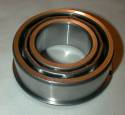

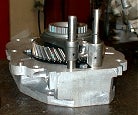
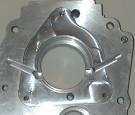











 Your Privacy Choices
Your Privacy Choices